Update August 2024 Thanks to Irfan, they have pointed out that the official MS recovery tool can be made to work with non-OEM surface hub SSDs using these instructions over on Charsiurice’s blog here.
Please note: I have no idea how this works with the new MTRoW Teams software load (I don’t have access to a Surface Hub anymore I’m afraid)
Original article.
I don’t know about you, but I roll out a fair few Surface Hub devices for clients and the main issue is. Every time I pull them out of the box they are on a really old build of Windows Team. These older versions have some issues with certain scenarios and the newer builds change the look at feel of the device a little. So I always try to have the device on the latest version when commissioning a new unit for a customer. The issue was there was only two supported ways of doing this.
- Sign the device in to my test account online, force it to update and wait a few hours
- Re-image the device by “turning it off” during the boot process and forcing an online recovery (overnight)
Both of these options are really frikken slow and have to be done onsite at the customers office. So our solution has been to carry some “Pre-imaged” SSD’s with us to swap out when we arrive onsite. But the issue was we either needed to re-image these in our Surface Hub in the office, or use my dodgy hacked together CloneZilla server to prepare disks.
So when I saw Y0av post this on his LinkedIn this morning I was really excited

His post links to the first public build of the Surface Hub Recovery Tool from the Microsoft website.
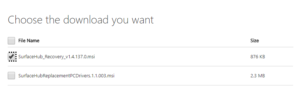
Download the SurfaceHub_Recovery_v1.4.137.0.msi (version number may change) file and install it on a PC with;
- Windows 10 1607 or better
- At least 10 GB free disk space on C:
- Some method of connecting a SATA disk that doesn’t mask the drive ID, a list of tested USB to SATA cables is below.
Here are the official requirements from help.txt included in the package
Introduction:
This tool was designed to help reimage your Surface Hub Solid State Drives (SSD) in a timely manner without calling for support or replacing the SSD itself. This will not fix physically damaged SSDs. You will need to call support if this reimaging tool does not restore your factory image.
Time to download the recovery image is dependent on internet connection speeds. On an average corporate connection, it can take up to an hour to download a 10GB file.Requirements:
Host computer running Windows 10 “Version 1607” or higher.
Internet access
USB -> SATA cable
10 GB of free disk space on the host computer
SSDs shipped with Surface Hub or an SSD provided by Support as a replacement. Other SSD’s are not supported.Recommendations:
High-speed Internet connection
USB 3.0 or higher USB -> SATA cable
Tested Make and model of cables:
Startech USB312SAT3CB
Rosewill RCUC16001
Ugreen 20231
Now we know we are good, we can install the tool by firing up the MSI and following the bouncing ball.
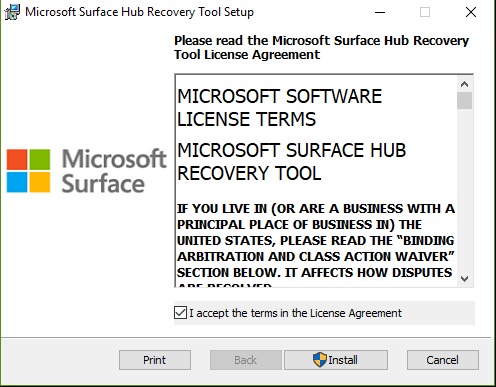
Once the tool is installed, it pop up in your start menu as Microsoft Surface Hub Recovery Tool
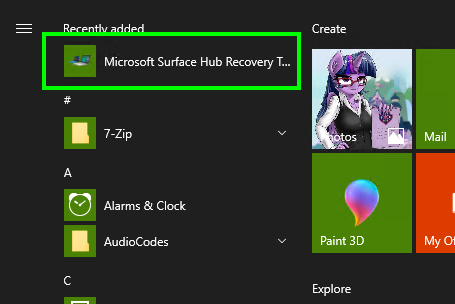
Launching the app will ask for admin rights and show a welcome screen.
The Learn More link simply takes you to this PDF on how to remove and replace the SSD in the Surface Hub or you can watch the video below.

Clicking on start will ask if you want to download the image for the Surface Hub.
This gets stored in C:\Program Files\Microsoft Surface Hub Recovery Tool\install.wim
and as Y0av reminded me, you can then just copy this WIM file between machines if you don’t want to download it again.
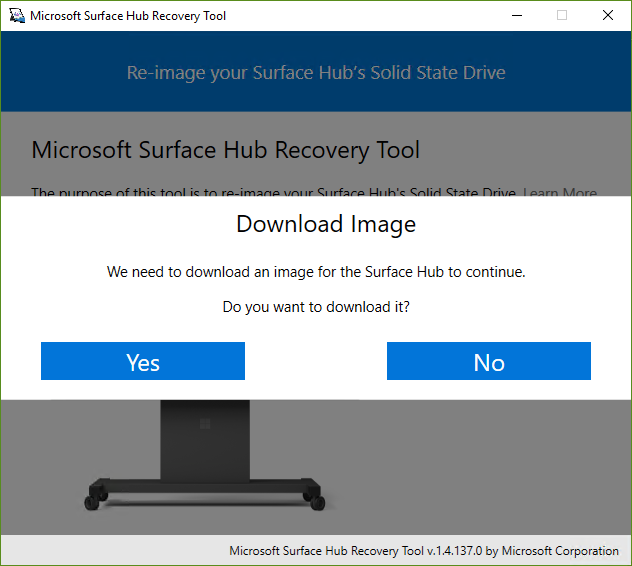
The download took me about 6 Hours on a 100mbit connection but once you have it, you have it right?
Whilst you wait for that to download. Go shutdown your Surface Hub, turn off the AC power, remove the SSD and connect it to your PC/USB Adapter
(excuse the shaky video, I’m still using very old gear)
Once you have the drive connected to your PC using a supported method the tool should change from this
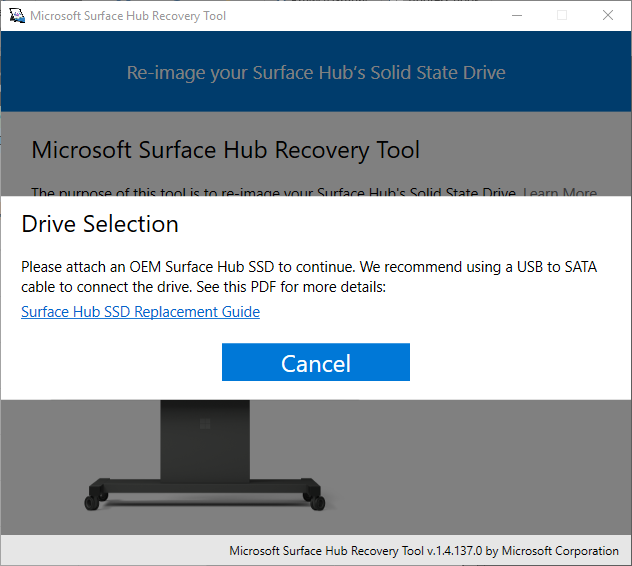
To this;

Note: The tool does do some sort of checking to see if its a Surface Hub drive, it seems to be looking specifically for a Lite-On SSD.
I tried popping a generic disk in and it never showed up, so don’t expect to make a fleet of spare disks to carry with you using this tool.
Make sure your Surface Hub SSD is selected and hit Start.
(No seriously. Make sure its the Surface Hub drive. This tool formats whatever you select, so if you don’t want to lose your My Little Pony collection watch out)
It gets stuck for a little while at a few different places. Don’t worry, its still copying. If you really think its stuck, restarting it wont break the SSD, but it will be unusable until you re-image it.
Once that’s done, Pull the disk out and pop it in your Surface Hub. Then continue your build as per normal.
Hope this helps. Thanks to Y0av and the Surface Hub team for making this available for us.
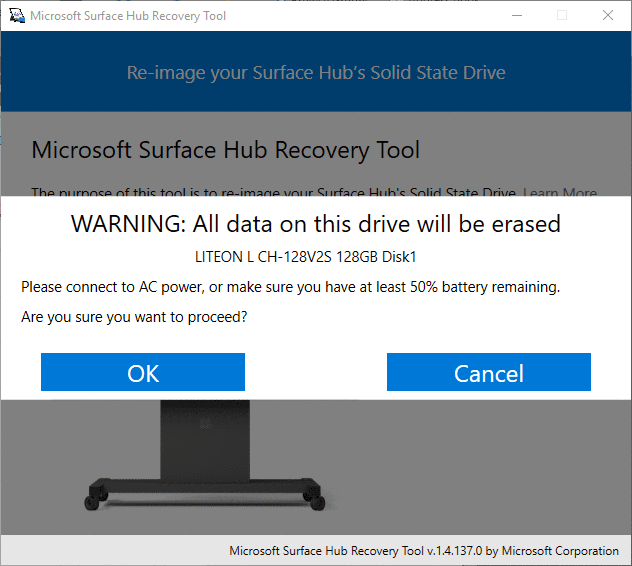
Pingback: Re-Image your Surface Hub the fast and easy way | Skype4BAdmin.com – JC's Blog-O-Gibberish
Hi,
I am trying recovery tool. it’s getting failed while download. I tried from multiple laptops.
There was mention of issues downloading large ISO’s from Microsoft the other day. Have you tried again?
I’ve tested from my machine and I’ve been able to download the entire image.
Hi,
I tried multiple times but it’s getting failed.
The only thing I can really suggest is trying from a different machine/internet connection.
Otherwise you can always log a case w/Microsoft as its their product. I’ve just posted the HowTo:
How are you doing this without a USB 3 to SATA? when i plug onto my motherboard it comes up as the right drive name, but it doesnt recognise the hard drive? please help thanks.
Hi Ben. Make sure that your motherboard is set to AHCI/SATA for that sata port instead of using a built in RAID controller. Even in JBOD mode the controller won’t allow certain ATA commands through to the risk which would be required to identify the SSD
I re-imaged a MS Hub 54″ with an USB2SATAIDE Startech adapter and everything went well. At the end the drive was Z and I saw the folders on it (Program Files etc)
However when I put back the SSD to the MS Hub the problem was still same, no change.
The issue with MS Hub is:
When is ON the screen is black. When you change the input shows: PC… or DP or VGA or HDMI etc
I connected a surface to it with an HDMI cable is it was OK. I showed image, mirror was perfect.
I turn it OFF with the power button and ON but it I don’t see the logon or anything on the screen. It is simply black. Again, when you change the input shows: PC… or DP or VGA or HDMI
I don’t know what else to try.
Can you please give me an idea? Thank you.
Couple of things I could think of.
The Motherboard has failed, Check the Status LEDs through the casing to see if you can see it powering up
The Surface Hub is in PC replacement mode, Check the two PC replacement mode switches on the bottom (details in the manual below)
Grab the user manual from here https://docs.microsoft.com/en-us/surface-hub/surface-hub-downloads?WT.mc_id=M365-MVP-5003444
Thank you so much. It worked!
MS Hub was in Replacement PC Mode. I switched and it booted.
Thank you so much!
Good to see I can help
hi guys above instructions are great but will only work with Surface hub original disk and their certified cables but if you want to install image on a normal SSD below instruction are very useful
https://charsiurice.wordpress.com/2021/01/29/reimaging-first-gen-surface-hub-with-surface-hub-recovery-tool-shrt/comment-page-1/#respond
thought it would be helpful
Can you complete the setup and build on one Surface Hub and ship it out to be installed into another?
hi guys above instructions are great but will only work with Surface hub original disk and their certified cables but if you want to install image on a normal SSD below instruction are very useful
https://charsiurice.wordpress.com/2021/01/29/reimaging-first-gen-surface-hub-with-surface-hub-recovery-tool-shrt/comment-page-1/#respond
thought it would be helpful
Thanks Irfan.
I’ve updated the post with the details